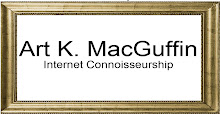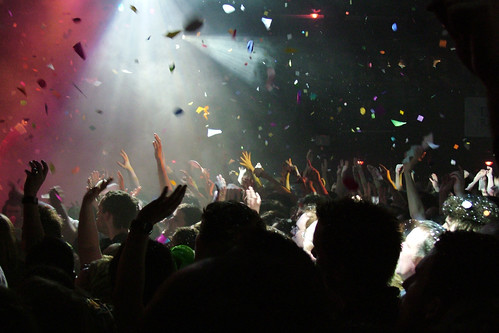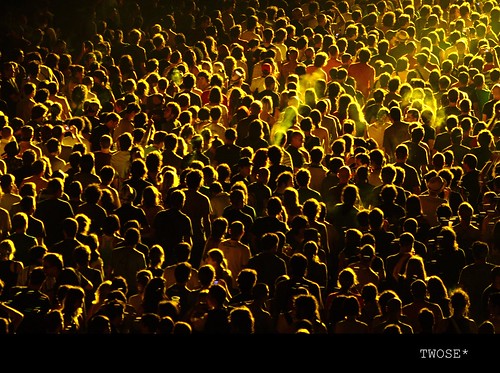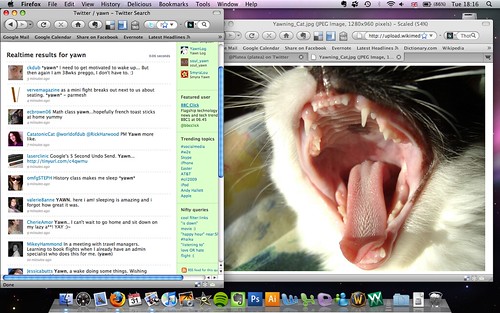
Photo courtesy freya_bean (click to view larger)
The Concept
On March 31 at 1:15 p.m. Eastern Time (10:15 a.m. Pacific and 5:15 p.m. Greenwich Mean), we launched The Great Yawn, the first performance piece of @Platea. It was a "twerformance art" flash mob, i.e., a statusing (online happening), aimed at examining the twin tensions of Twitter: that it's boring and mundane and that it's an exciting place for viral, up-to-the-second news. After amassing some 350 members, we asked everyone, at the appointed time, to tweet about yawning. It could be anything - an expression of tiredness (@Molo), a reply to someone's message (@hotpinksheets), an act of poetry (@pensivestudio), a historical tidbit (@publichistorian), even a pun (@kulex). All that mattered was that they use the word "yawn" in their message.
I chose yawning because of its interesting parallels with Twitter and the way it breaks past the boundaries of digital space and into physical space. As traditional flash mobs' effectiveness comes from their physicality, this latter part was key. It's a basic psychological phenomenon that when you see someone yawn or even when you think about yawning, you can't help but yawn yourself (are you yawning yet?). As I described this concept to @Platea members, a number of them told me they were yawning just thinking about it. And yet, the purpose of yawning is mysterious. Like Twitter, it has an unclear usefulness for human beings, and yet, like Twitter, it is highly contagious and spreads rapidly in social circles.
This was largely an experimental piece, our first shot at a free-form public art performance on Twitter, inspired by real-world flash mobs and happenings. As I mentioned in my Twitterview with Hrag Vartanian, I was less concerned about numbers per se and would consider the project successful if it got a dialogue going around social media and public art and if folks were engaged. By that measure, I was super happy with how things went, and I'm excited to recap some of it here.
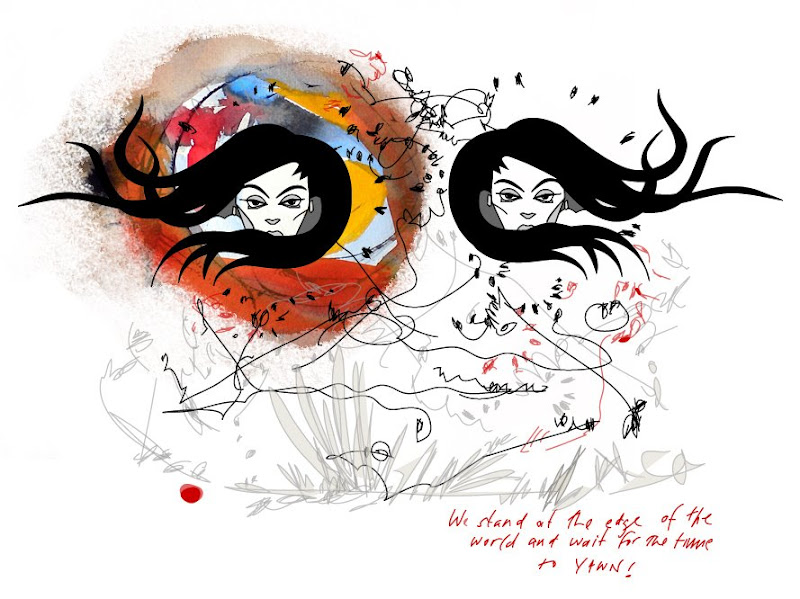
The absolutely heroic Twitpic and tweet from @stonefly in Tasmania... live at 4:15 a.m.!
So What Happened?
So what happens when you ask 350 people to yawn into the Twittersphere at the same time? Here's what we found.
Firstly, after a rough count, we got some 100 yawns, just from @Platea's followers alone. This was a pretty impressive number of people to be yawning at the same time (haven't seen that since undergrad lecture hall!), but it's less than 1/3 of our followers. We suspect this was due to the fact that the flash mob membership was spread out from California to Tasmania, and that many followers were participating during the work week.
Secondly, there was some last-minute synchronization confusion around the fact that we said the mob would occur at "5:15 GMT". London had just recently switched to daylight savings time, technically putting all our UK users at GMT+1. So we saw some early yawners, and I do apologize for that bit of confusion! We finally shared out time.gov as a common clock and a handy dandy time zone chart from @taphead. I can only imagine how confusing it must be for air traffic controllers and other folks who regularly work internationally.
Thirdly, folks just couldn't stop yawning! @Micrathene tweeted, "Another yawn - sorry, I just can't seem to stop." Nikki tweeted, "*yawn* suddenly very 'stweepy' not really stopped yawning all day. Isn't it odd how seeing or reading a yawn makes you yawn even more?" And, impressively, we did get some side effect yawns from non-@Platea members. @Fi4all: "(((((((((((yaaaaaaaaaaaaaaaaawnnnn))))))))) ewwwwwwwwe... look what you've STARTED!! *Ü*" And @reverendreasons: "Wow! Nailed me. I guess I yawned too. Very wily!"
But, really, it was a lot of fun. "I am just cracking up here my myself in my studio!", tweeted @joanie_s_c. @canker's cat joined in, "Here, we have the finalist for biggest kitty yawn: Mia. The yawn is accompanied by a biiiig stretch and a brisk shakeoff to end. *applause*", as did @schun's: "An says, "yawn!" Cat complies, and stretches, too." @Cobwebsstir's son tweeted theirs from a cell phone as they pulled out of a restaurant parking lot, and @joanie_s_c and @_randomthoughts had a hoot talking to each other about getting caffeine to stay awake.
A video yawned by @mattressfactory
Where Were You During the Great Yawn?
I asked folks to send in pictures about their experience with The Great Yawn, both documenting the performance and answering the question, "Where were you during The Great Yawn?"

@sw00p was listening, appropriately enough, to Iggy Pop's "I'm Bored" for inspiration while he monitored the public timeline (which moved too quickly to really register our yawns).
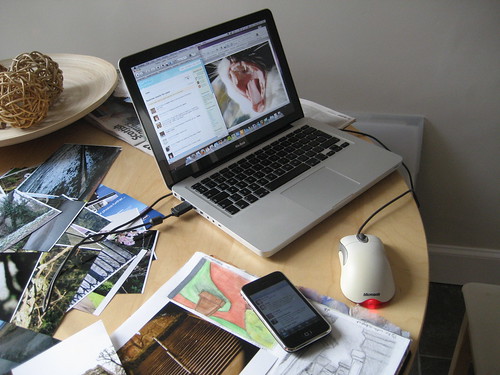
Freya_bean was at her desk, yawning away
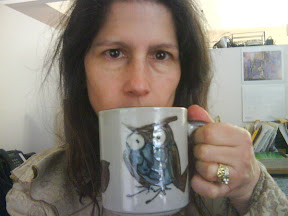

@joanie_s_c and @_randomthoughts shared a virtual coffee

@raggedj set up a last-minute delayed yawn and both tweeted and took a screenshot on the I-20: "I had a blast participating in the Great Yawn! I found out at 12:45 that afternoon that I had to drive to a nearby town and would be on the road at 1:15. I quickly set myself up with a hootsuite account, scheduled my yawn,, and hit the road. I was hoping to make my destination by the event, bit that was not to happen. Here then, is one of several sceenshots of a public search for "yawn" taken on my phone at 1:15 while doing 80 down I-20."

Unfortunately, not everyone experienced The Great Yawn equally, as clockspot attested: "I wasn't sure what to watch during the Tweet Yawn - the public timeline goes so quickly - so I just watched my regular feed. Sadly uneventful." I had a theory that, since participation in the flash mob was virally marketed, most @Platea members would already be linked to each other to witness each other's yawns.

From @_randomthoughts, who was well-connected with other @Platea participants (click to view larger)
This appeared to be mostly true (or was it? It's hard to tell from one perspective), but next time, it probably makes sense to ask people to follow each other to get the full effect. And unfortunately, even if some people yawn, there's no way to know unless they tweet about it (as @kurometarikku discovered).

Others, like @sortingtrolley, well, they yawned so hard they fell asleep!
But surely this can't be it. I've probably missed many great moments and some great shots, and frankly, I'm curious to hear how it went for everyone else. Consider this an open thread - what were your favorite yawns? How was the experience for you? Anything you'd change for a future flash mob? Anything you'd keep? And for goodness sake, can we all stop yawning already? Please post your thoughts in the comments, and share and share alike!
